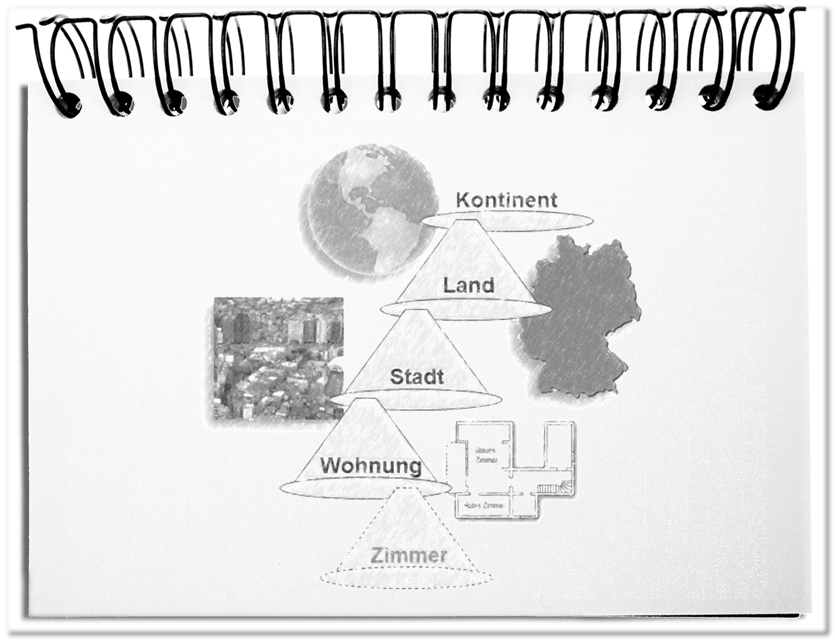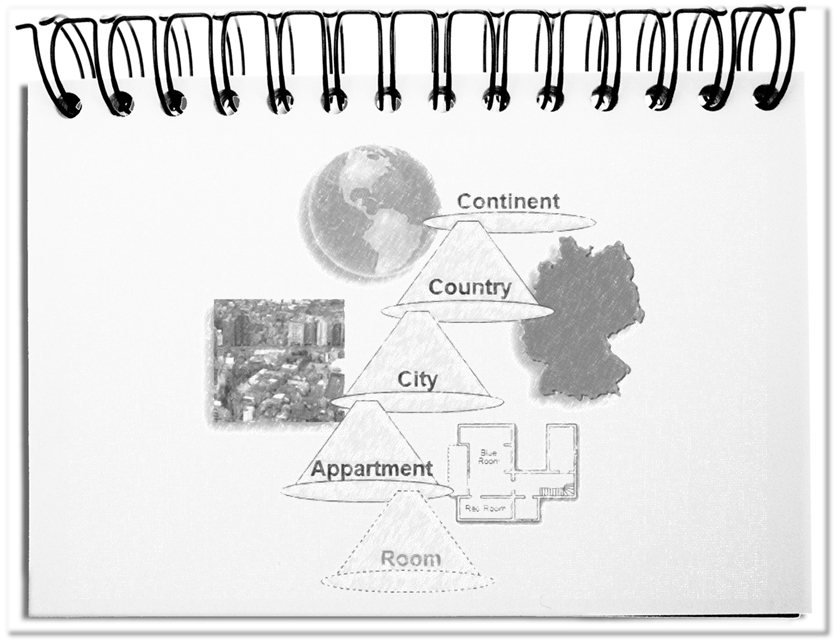Der Blick auf die Welt ist bestimmt durch die Werkzeuge und unseren Standort, die wir nutzen, um die Wirklichkeit zu betrachten. Das Teleskop ermöglicht den Blick in die Ferne. Die kleinen Dinge werden durch das Mikroskop sichtbar gemacht. Wir haben gelernt mit unterschiedlichen Ebenen der Detaillierung umzugehen, indem wir stets die Reichweite und die Auflösung unseres Betrachtungsraums festlegen. Den gesamten Bereich nennen wir das Ganze. Die darin enthaltenen, vernetzten Teile sind für sich genommen wiederum Systeme, die aus Teilen bestehen, und so fort. Jede Ebene hat gesonderte Eigenschaften zuzüglich der Eigenschaften, die sich aus dem Zusammenspiel für das Ganze ergeben. Darum sprechen wir von: Das Ganze ist mehr als die Summe seiner Teile.
Ein System ist ein abstrakter Begriff für eine Ganzheit, die Teile und Beziehungen zu einem „Objekt“ bündelt, das abgegrenzt von der Umwelt funktioniert. Um ein System bewusst zu nutzen, ist es erforderlich, es zu beschreiben und seine Muster zu erkennen. Manche Systeme haben sich aus natürlichen Gegebenheiten entwickelt. Beispiele sind das Sonnensystem, Tiere und Menschen, ein Wald oder ein See, das Gehirn, das Immunsystem, usw. Andere Systeme haben die Menschen geschaffen. Beispiele sind hier Maschinen, Fahrzeuge, Thermostate, Software, Hardware, Wirtschaftssysteme, Rechtssysteme, Religionen, Politik, Produkte, Dienstleistungen, usw. Diese Listen lassen sich beliebig erweitern.
Betrachten wir die beiden folgenden Beispiele: die Welt und das Unternehmen.
- Welt
- Unser Weltbild hat sich immer weiter konkretisiert – von der ersten Karte, über den Globus bis hin zu Google Street View.
- Wahrscheinlich sitzen Sie irgendwo draußen oder in einem Zimmer (z.B. einem Büro, einem Café, einem Zugabteil). Eigenschaften sind dabei das Inventar, die Infrastruktur, die Größe usw.
- Das Zimmer befindet sich in einem Komplex (z.B. einem Haus, einem Bürogebäude, einem Zug). Eigenschaften sind die Anzahl Etagen, die Anzahl Gebäude und die Zugänge.
- Die Wohnung befindet sich in einer Stadt (z.B. einer Megacity, einer Kleinstadt oder einem Dorf). Eigenschaften sind die Anzahl Bewohner, die Anbindung an den öffentlichen Verkehr und die Wirtschaftskraft.
- Die Stadt befindet sich in einem Land (z.B. Deutschland, USA, Brasilien, Japan). Eigenschaften sind das Bruttonationaleinkommen, das Bruttonationalglück und die politische Stabilität.
- Das Land befindet sich auf einem Kontinent (z.B. Amerika, Europa, Asien). Eigenschaften sind die Wirtschaftszonen, die Klimazonen und die Bevölkerungsdichte.
- Unternehmen
- Im Unternehmen werden jeder Ebene Aufgaben, Kompetenzen und Verantwortung (AKV) zugeordnet, die möglichst überschneidungsfrei sein sollen.
- Die Stelle, die ein Mitarbeiter ausfüllt, ist unternehmerisch die feinste Ebene (z.B. der Pförtner, die Reinigungskraft, die Sachbearbeiter, die Führungskräfte, der Vorstand). Eigenschaften sind neben den AKV das Commitment, die Erfahrung und die Fähigkeiten.
- Die Stellen werden in Teams gebündelt, die sich an Funktionen oder Abläufen orientieren (z.B. die Entwicklung von Außenspiegeln, der Rechnungseingang). Eigenschaften sind neben der AKV die Gruppendynamik, der Zusammenhalt und die Produktivität.
- Abteilungen bestehen aus Teams (z.B. das computergestützte Design, die Buchhaltung, die Logistik Übersee). Eigenschaften sind neben der AKV die Machtstrukturen, der interne Wettbewerb und die Altlasten.
- Die Abteilungen sind Funktionen zugeordnet (z.B. Forschung & Entwicklung, Finanzen & Controlling, Logistik). Eigenschaften sind neben der AKV der Einfluss, die Innovationsfähigkeit und die Eigenständigkeit.
- Die Funktionsbereiche gehören zu Unternehmen (z.B. Flugzeugherstellern, Softwarehäusern, Speditionen). Eigenschaften sind neben der AKV die Branche, die Unternehmensform und der Umsatz.
Die einzelnen Ebenen ergeben eine Summe von Eigenschaften für das Gesamtsystem, die größer ist als die Summe der einzelnen Ebenen.
Im klassischen Silodenken gibt es diesen Blickwinkel nicht. Die synergetischen Eigenschaften der übergeordneten Ebenen sehen die unteren Ebenen nicht. Gleichzeitig wird in den Silos viel Energie durch internen Wettbewerb verschwendet, der keinen Mehrwert für das Ganze erbringt.
Aus dem systemischen Blickwinkel liegt der Fokus auf dem Ganzen – auf den Vorteilen, die sich aus dem Zusammenspiel aller Elemente ergeben. Folgende Aspekte helfen dabei, diese Ertragsquellen zu erschließen.
- Beschreiben Sie Ihr System. Welche Elemente gibt es und in welcher Beziehung stehen sie zueinander? Dadurch schaffen Sie Klarheit für echte Verbesserungen für das Ganze.
- Ordnen Sie die Aufgaben, die Kompetenzen und die Verantwortung entsprechend zu. Dadurch schaffen Sie autarke Teilsysteme, die eigenständig agieren und dadurch Doppelarbeit und Reibungsverluste vermeiden.
- Beobachten Sie kontinuierlich Ihr System bezüglich sich ergebender Muster. Das ermöglicht bei Anomalien frühzeitig, mit relativ geringem Aufwand, gegenzusteuern.
- Die ganzheitliche Betrachtung stellt sicher, dass Sie Ihre Abläufe so ausgestalten, dass die einzelnen Aktivitäten einen Mehrwert für das Ganze Sie regeln derart, dass die einzelnen Teile sich ergänzen und nicht gegenseitig Aufwände und Kosten hin und her schieben.
- Der entscheidende Faktor des Systems ist die Bedeutung, die die Daten und die Informationen vermitteln. Damit bieten Sie den Beteiligten die Möglichkeit, das Richtige richtig zu tun.
Fazit: Die Festlegung des Systems verbessert dessen Steuerung. Jedes System besteht aus Teilen, die ebenfalls als System beschrieben werden können. Gleichzeitig ist jedes System ein Bestandteil eines übergeordneten Systems. Mit dem Blick auf das jeweilige Ganze können die Elemente und Beziehungen festgelegt werden. Das Geschehen jenseits der Grenzen des Ganzen wird erst dann interessant, wenn es auf das eigene Ganze trifft. Damit lassen sich die Aufgaben, Kompetenzen und Verantwortlichkeiten abstecken und der Gewinn für das Ganze absichern. Aktivitäten, die außerhalb dieser Grenzen liegen, verantworten und wickeln Andere ab.


